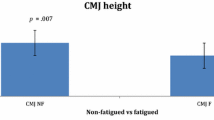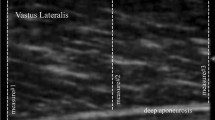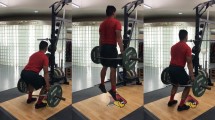Abstract
Purpose
This study investigated hamstring activation in the frequency domain and jump-landing performance in a specialized-training athletic population and a healthy control group.
Methods
Thirty male athletes engaged in power training, both with and without jumping sports, or endurance training, together with ten healthy participants were recruited. Surface EMG electrodes were attached to the bellies of the lateral hamstring (LH) and medial hamstring (MH). The median EMG frequency was analyzed during takeoff, flight, before ground contact, after ground contact, and landing in countermovement jumps (CMJ) and drop-vertical jumps (DJ). Kinetic outcomes were also investigated.
Results
The power-trained athletes (with and without jumping sports) exhibited a lower median EMG frequency in the MH during takeoff (p = 0.001 for DJ) and in the LH (p = 0.008 for DJ) and MH during landing (p = 0.004 for CMJ and 0.001 for DJ) compared with the endurance-trained or control groups. Furthermore, the power-trained group demonstrated greater jump heights (p = 0.009 for CMJ and p = 0.003 for DJ). All the athletic groups showed a lower landing force (p = 0.022) and loading rate (p = 0.043) in CMJ than the control group.
Conclusion
Training background differences influenced hamstring recruitment during jumping. Power-trained athletes exhibited a lower median EMG frequency and better jumping performance. All the athletes demonstrated a more effective landing strategy than the control group. These findings suggest the potential for enhancing athletic performance and aiding in landing strategy by exploiting different training styles.




Similar content being viewed by others
Data Availability
The raw or processed data can be made available upon request that is deemed reasonable.
References
Blaauw, B., Schiaffino, S., & Reggiani, C. (2013). Mechanisms modulating skeletal muscle phenotype. Comprehensive Physiology, 3(4), 1645–1687. https://doi.org/10.1002/cphy.c130009
Plotkin, D. L., Roberts, M. D., Haun, C. T., & Schoenfeld, B. J. (2021). Muscle fiber type transitions with exercise training: shifting perspectives. Sports (Basel), 9(9), 127. https://doi.org/10.3390/sports9090127
Wilson, J. M., Loenneke, J. P., Jo, E., Wilson, G. J., Zourdos, M. C., & Kim, J. S. (2012). The effects of endurance, strength, and power training on muscle fiber type shifting. Journal of Strength and Conditioning Research, 26(6), 1724–1729. https://doi.org/10.1519/JSC.0b013e318234eb6f
Degens, H., Stasiulis, A., Skurvydas, A., Statkeviciene, B., & Venckunas, T. (2019). Physiological comparison between non-athletes, endurance, power and team athletes. European Journal of Applied Physiology, 119(6), 1377–1386. https://doi.org/10.1007/s00421-019-04128-3
Loturco, I., Gil, S., Laurino, C. F., Roschel, H., Kobal, R., Cal Abad, C. C., et al. (2015). Differences in muscle mechanical properties between elite power and endurance athletes: A comparative study. Journal of Strength and Conditioning Research, 29(6), 1723–1728. https://doi.org/10.1519/jsc.0000000000000803
Afonso, J., Rocha-Rodrigues, S., Clemente, F. M., Aquino, M., Nikolaidis, P. T., Sarmento, H., et al. (2021). The hamstrings: anatomic and physiologic variations and their potential relationships with injury risk. Frontiers in Physiology, 12, 694604. https://doi.org/10.3389/fphys.2021.694604
Avrillon, S., Lacourpaille, L., Hug, F., Le Sant, G., Frey, A., Nordez, A., et al. (2020). Hamstring muscle elasticity differs in specialized high-performance athletes. Scandinavian Journal of Medicine and Science in Sports, 30(1), 83–91. https://doi.org/10.1111/sms.13564
Kawama, R., Okudaira, M., Shimasaki, T., Maemura, H., & Tanigawa, S. (2021). Sub-elite sprinters and rugby players possess different morphological characteristics of the individual hamstrings and quadriceps muscles. PLoS ONE, 16(10), e0259039. https://doi.org/10.1371/journal.pone.0259039
Pedley, J. S., Lloyd, R. S., Read, P. J., Moore, I. S., De Ste Croix, M., Myer, G. D., et al. (2020). Utility of kinetic and kinematic jumping and landing variables as predictors of injury risk: A systematic review. J Sci Sport Exerc, 2(4), 287–304. https://doi.org/10.1007/s42978-020-00090-1
Dewig, D. R., Goodwin, J. S., Pietrosimone, B. G., & Blackburn, J. T. (2020). Associations among eccentric hamstrings strength, hamstrings stiffness, and jump-landing biomechanics. Journal of Athletic Training, 55(7), 717–723. https://doi.org/10.4085/1062-6050-151-19
Blackburn, J. T., Norcross, M. F., Cannon, L. N., & Zinder, S. M. (2013). Hamstrings stiffness and landing biomechanics linked to anterior cruciate ligament loading. Journal of Athletic Training, 48(6), 764–772. https://doi.org/10.4085/1062-6050-48.4.01
Krommes, K., Jakobsen, M. D., Bandholm, T., Andersen, L. L., Zebis, M., Shield, A., et al. (2021). Cross-sectional study of EMG and EMG rise during fast and slow hamstring exercises. International Journal of Sports Physical Therapy, 16(4), 1033–1042. https://doi.org/10.26603/001c.25364
Suskens, J. J. M., Maas, H., van Dieën, J. H., Kerkhoffs, G., Goedhart, E. A., Tol, J. L., et al. (2023). The effect of the Nordic hamstring exercise on muscle activity: A multichannel electromyography randomized controlled trial. Journal of Applied Biomechanics, 39(6), 377–387. https://doi.org/10.1123/jab.2023-0037
Váczi, M., Fazekas, G., Pilissy, T., Cselkó, A., Trzaskoma, L., Sebesi, B., et al. (2022). The effects of eccentric hamstring exercise training in young female handball players. European Journal of Applied Physiology, 122(4), 955–964. https://doi.org/10.1007/s00421-022-04888-5
Massó, N., Rey, F., Romero, D., & Gual, G. (2010). Surface electromyography applications in the sport. Apunts Med Esport, 45(168), 127–136.
Phinyomark, A., Phukpattaranont, P., & Limsakul, C. (2012). Feature reduction and selection for EMG signal classification. Expert Systems with Applications, 39(8), 7420–7431. https://doi.org/10.1016/j.eswa.2012.01.102
Phinyomark, A. T., S., Hu, H., Phukpattaranont, P., & Limsakul, C. (2012) The usefulness of mean and median frequencies in electromyography analysis. In: Naik GR (Ed.), Computational intelligence in electromyography analysis – A perspective on current applications and future challenges (pp. 195–220). IntechOpen.
Chan, C. K., Timothy, G. F., & Yeow, C. H. (2016). Comparison of mean frequency and median frequency in evaluating muscle fiber type selection in varying gait speed across healthy young adult individuals. Annual International Conference of the IEEE Engineering in Medicine and Biology Society, 2016, 1725–8. https://doi.org/10.1109/embc.2016.7591049
Jankaew, A., Jan, Y. K., Hwang, I. S., Kuo, L. C., & Lin, C. F. (2023). Hamstring muscle stiffness affects lower extremity muscle recruitment and landing forces during double-legs vertical jump. Sports Biomechanics. Advance online publication. https://doi.org/10.1080/14763141.2023.2219670
Solomonow, M., Baten, C., Smit, J., Baratta, R., Hermens, H., D’Ambrosia, R., et al. (1990). Electromyogram power spectra frequencies associated with motor unit recruitment strategies. Journal of Applied Physiology, 68(3), 1177–1185. https://doi.org/10.1152/jappl.1990.68.3.1177
Conceição, M., Cadore, E. L., González-Izal, M., Izquierdo, M., Liedtke, G. V., Wilhelm, E. N., et al. (2014). Strength training prior to endurance exercise: impact on the neuromuscular system, endurance performance and cardiorespiratory responses. J Hum Kinet, 44, 171–81. https://doi.org/10.2478/hukin-2014-0123
Wang, M. H., Chen, K. C., Hung, M. H., Chang, C. Y., Ho, C. S., Chang, C. H., et al. (2020). Effects of plyometric training on surface electromyographic activity and performance during blocking jumps in college division I men’s volleyball athletes. Applied Sciences, 10(13), 4535. https://doi.org/10.3390/app10134535
Guan, S., Lin, N., Yin, Y., Liu, H., Liu, L., & Qi, L. (2021). The effects of inter-set recovery time on explosive power, electromyography activity, and tissue oxygenation during plyometric training. Sensors, 21(9), 3015. https://doi.org/10.3390/s21093015
Craig, C. L., Marshall, A. L., Sjöström, M., Bauman, A. E., Booth, M. L., Ainsworth, B. E., et al. (2003). International physical activity questionnaire: 12-country reliability and validity. Medicine and Science in Sports and Exercise, 35(8), 1381–1395. https://doi.org/10.1249/01.Mss.0000078924.61453.Fb
Ramirez-Campillo, R., Sortwell, A., Moran, J., Afonso, J., Clemente, F. M., Lloyd, R. S., et al. (2023). Plyometric-jump training effects on physical fitness and sport-specific performance according to maturity: A systematic review with meta-analysis. Sports Medicine Open, 9(1), 23. https://doi.org/10.1186/s40798-023-00568-6
Kobal, R., Nakamura, F. Y., Kitamura, K., Cal Abad, C. C., Pereira, L. A., & Loturco, I. (2017). Vertical and depth jumping performance in elite athletes from different sports specialties. Science & Sports, 32(5), e191–e196. https://doi.org/10.1016/j.scispo.2017.01.007
Ramírez-delaCruz, M., Bravo-Sánchez, A., Esteban-García, P., Jiménez, F., & Abián-Vicén, J. (2022). Effects of plyometric training on lower body muscle architecture, tendon structure, stiffness and physical performance: A systematic review and meta-analysis. Sports Medicine Open, 8(1), 40. https://doi.org/10.1186/s40798-022-00431-0
Wilder, J. N., Riggins, E. R., Noble, R. A., Lelito, C. M., Widenhoefer, T. L., & Almonroeder, T. G. (2020). The effects of drop vertical jump technique on landing and jumping kinetics and jump performance. Journal of Electromyography and Kinesiology, 56, 102504. https://doi.org/10.1016/j.jelekin.2020.102504
Stensrud, S., Myklebust, G., Kristianslund, E., Bahr, R., & Krosshaug, T. (2011). Correlation between two-dimensional video analysis and subjective assessment in evaluating knee control among elite female team handball players. British Journal of Sports Medicine, 45(7), 589–595. https://doi.org/10.1136/bjsm.2010.078287
Jankaew, A., Jan, Y. K., Hwang, I. S., Kuo, L. C., & Lin, C. F. (2023). Hamstring activation deficits in different jumping directions in athletes with a history of hamstring strain injuries: A cross-sectional laboratory study. Sports Biomechanics. Advance online publication. https://doi.org/10.1080/14763141.2023.2236074
Sole, G., Milosavljevic, S., Nicholson, H., & Sullivan, S. J. (2012). Altered muscle activation following hamstring injuries. British Journal of Sports Medicine, 46(2), 118–123. https://doi.org/10.1136/bjsm.2010.079343
Paterno, M. V., Ford, K. R., Myer, G. D., Heyl, R., & Hewett, T. E. (2007). Limb asymmetries in landing and jumping 2 years following anterior cruciate ligament reconstruction. Clinical Journal of Sport Medicine, 17(4), 258–262. https://doi.org/10.1097/JSM.0b013e31804c77ea
Linthorne, N. P. (2001). Analysis of standing vertical jumps using a force platform. American Journal of Physics, 69(11), 1998–2204. https://doi.org/10.1119/1.1397460
Turner, A. N., & Jeffreys, I. (2010). The stretch-shortening cycle: Proposed mechanisms and methods for enhancement. Strength & Conditioning Journal, 32, 87–99. https://doi.org/10.1519/SSC.0b013e3181e928f9
Qaisar, R., Bhaskaran, S., & Van Remmen, H. (2016). Muscle fiber type diversification during exercise and regeneration. Free Radical Biology and Medicine, 98, 56–67. https://doi.org/10.1016/j.freeradbiomed.2016.03.025
Methenitis, S., Karandreas, N., Spengos, K., Zaras, N., Stasinaki, A. N., & Terzis, G. (2016). Muscle fiber conduction velocity, muscle fiber composition, and power performance. Medicine and Science in Sports and Exercise, 48(9), 1761–1771. https://doi.org/10.1249/mss.0000000000000954
Duchateau, J., Semmler, J. G., & Enoka, R. M. (2006). Training adaptations in the behavior of human motor units. Journal of Applied Physiology (1985), 101(6), 1766–1775. https://doi.org/10.1152/japplphysiol.00543.2006
Jurasz, M., Boraczyński, M., Wójcik, Z., & Gronek, P. (2022). Neuromuscular fatigue responses of endurance- and strength-trained athletes during incremental cycling exercise. International Journal of Environmental Research and Public Health, 19(14), 8839. https://doi.org/10.3390/ijerph19148839
Manske, R., & Reiman, M. (2013). Functional performance testing for power and return to sports. Sports Health, 5(3), 244–250. https://doi.org/10.1177/1941738113479925
Bagley, L., McPhee, J. S., Ganse, B., Müller, K., Korhonen, M. T., Rittweger, J., et al. (2019). Similar relative decline in aerobic and anaerobic power with age in endurance and power master athletes of both sexes. Scandinavian Journal of Medicine and Science in Sports, 29(6), 791–799. https://doi.org/10.1111/sms.13404
Methenitis, S., Spengos, K., Zaras, N., Stasinaki, A. N., Papadimas, G., Karampatsos, G., et al. (2019). Fiber type composition and rate of force development in endurance- and resistance-trained individuals. Journal of Strength and Conditioning Research, 33(9), 2388–2397. https://doi.org/10.1519/jsc.0000000000002150
O’Connor, K. M., Johnson, C., & Benson, L. C. (2015). The effect of isolated hamstrings fatigue on landing and cutting mechanics. Journal of Applied Biomechanics, 31(4), 211–220. https://doi.org/10.1123/jab.2014-0098
Maniar, N., Carmichael, D. S., Hickey, J. T., Timmins, R. G., San Jose, A. J., Dickson, J., et al. (2023). Incidence and prevalence of hamstring injuries in field-based team sports: A systematic review and meta-analysis of 5952 injuries from over 7 million exposure hours. British Journal of Sports Medicine, 57(2), 109–116. https://doi.org/10.1136/bjsports-2021-104936
Cross, K. M., Gurka, K. K., Saliba, S., Conaway, M., & Hertel, J. (2013). Comparison of hamstring strain injury rates between male and female intercollegiate soccer athletes. American Journal of Sports Medicine, 41(4), 742–748. https://doi.org/10.1177/0363546513475342
Acknowledgements
The authors wish to thank the Motion Analysis Laboratory, Department of Biomedical Engineering, National Cheng Kung University, Taiwan, for providing the laboratory space and necessary equipment for the successful completion of this study.
Funding
The study was partially funded by the National Science & Technology Council, Taiwan (NSTC 112-2314-B-006-038).
Author information
Authors and Affiliations
Corresponding author
Ethics declarations
Competing interests
The authors declare that they have no conflicts of interest.
Ethical Approval
The experimental procedure was approved by the Research Ethics Committee of National Cheng Kung University Hospital under ethical approval number A-ER-110–075. All the participants provided written informed consent prior to participating in the study.
Rights and permissions
Springer Nature or its licensor (e.g. a society or other partner) holds exclusive rights to this article under a publishing agreement with the author(s) or other rightsholder(s); author self-archiving of the accepted manuscript version of this article is solely governed by the terms of such publishing agreement and applicable law.
About this article
Cite this article
Jankaew, A., Jan, YK. & Lin, CF. Frequency Domain Analysis of Hamstring Activation During Jump-Landing Performance by Athletes with Diverse Training Regimens. J. Med. Biol. Eng. (2024). https://doi.org/10.1007/s40846-024-00857-9
Received:
Accepted:
Published:
DOI: https://doi.org/10.1007/s40846-024-00857-9




